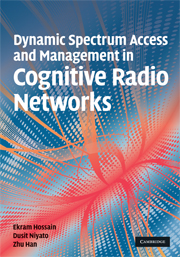Book contents
- Frontmatter
- Contents
- Preface
- Part I Introduction
- Part II Techniques for design, analysis, and optimization of dynamic spectrum access and management
- Part III Dynamic spectrum access and management
- 7 Dynamic spectrum access: models, architectures, and control
- 8 Centralized dynamic spectrum access
- 9 Distributed dynamic spectrum access: cooperative and non-cooperative approaches
- 10 Distributed dynamic spectrum access: learning algorithms and protocols
- 11 Economics of dynamic spectrum access: spectrum trading
- 12 Economics of dynamic spectrum access: applications of spectrum trading models
- References
- Index
8 - Centralized dynamic spectrum access
from Part III - Dynamic spectrum access and management
Published online by Cambridge University Press: 26 February 2010
- Frontmatter
- Contents
- Preface
- Part I Introduction
- Part II Techniques for design, analysis, and optimization of dynamic spectrum access and management
- Part III Dynamic spectrum access and management
- 7 Dynamic spectrum access: models, architectures, and control
- 8 Centralized dynamic spectrum access
- 9 Distributed dynamic spectrum access: cooperative and non-cooperative approaches
- 10 Distributed dynamic spectrum access: learning algorithms and protocols
- 11 Economics of dynamic spectrum access: spectrum trading
- 12 Economics of dynamic spectrum access: applications of spectrum trading models
- References
- Index
Summary
Introduction
In a centralized dynamic spectrum access architecture, a central controller is deployed to gather and process information about the wireless environment. With a central controller, the decision of cognitive radio users to access the spectrum can be made such that the desired system-wide objectives are achieved.
In this chapter, we review centralized dynamic spectrum access schemes. A summary of these schemes is provided in Table 8.1. In a centralized scheme, every cognitive radio user communicates with a central controller to inform their states and objectives/requirements. The central controller then makes the decisions in terms of the action for each cognitive radio user to access the spectrum so that their requirements are satisfied under given system constraints. To implement centralized dynamic spectrum access, two approaches, namely, optimization approach and auction-based approach, can be used. With an optimization-based approach, different types of optimization problems can be formulated (e.g. convex optimization, assignment problem, linear programming, and graph theory). Standard methods in optimization theory can then be applied to obtain the optimal solution for dynamic spectrum access. Alternatively, centralized dynamic spectrum access can be designed based on auction theory which is well developed in the field of economics. In this approach, cognitive radio users submit their bids to the spectrum owner. The winning cognitive radio user is determined from the bids, and the spectrum is allocated accordingly.
Optimization-based approach
Quality of service (QoS)-constrained dynamic spectrum access
With spectrum underlay access (i.e. the shared-use model), an optimization problem was formulated by considering QoS differentiation for different unlicensed users and also interference temperature constraints [452].
Information
- Type
- Chapter
- Information
- Publisher: Cambridge University PressPrint publication year: 2009
